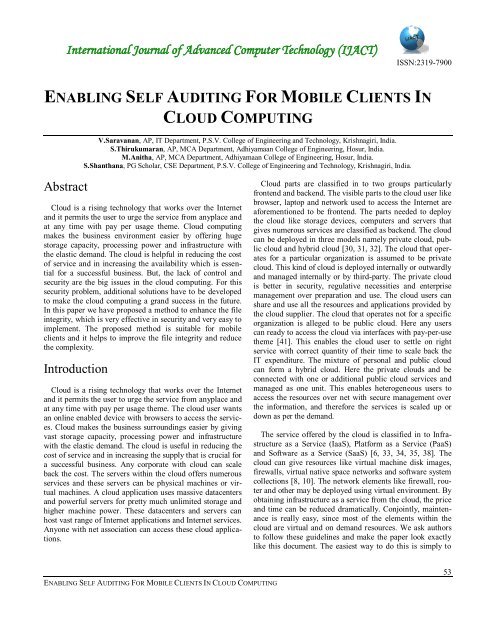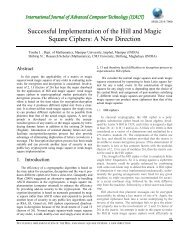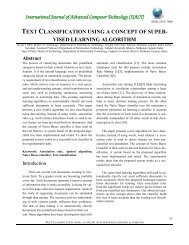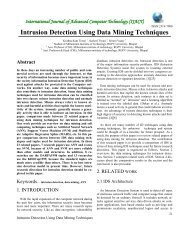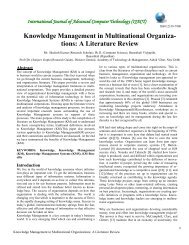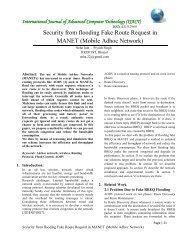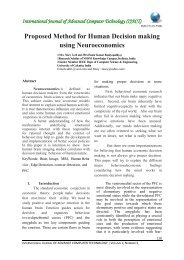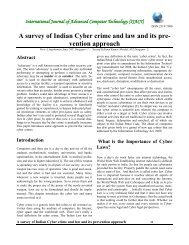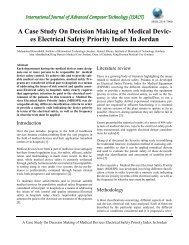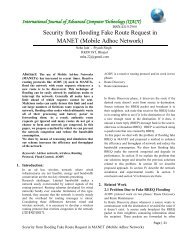enabling self auditing for mobile clients in cloud computing
enabling self auditing for mobile clients in cloud computing
enabling self auditing for mobile clients in cloud computing
Create successful ePaper yourself
Turn your PDF publications into a flip-book with our unique Google optimized e-Paper software.
International Journal of Advanced Computer Technology (IJACT)ISSN:2319-7900ENABLING SELF AUDITING FOR MOBILE CLIENTS INCLOUD COMPUTINGV.Saravanan, AP, IT Department, P.S.V. College of Eng<strong>in</strong>eer<strong>in</strong>g and Technology, Krishnagiri, India.S.Thirukumaran, AP, MCA Department, Adhiyamaan College of Eng<strong>in</strong>eer<strong>in</strong>g, Hosur, India.M.Anitha, AP, MCA Department, Adhiyamaan College of Eng<strong>in</strong>eer<strong>in</strong>g, Hosur, India.S.Shanthana, PG Scholar, CSE Department, P.S.V. College of Eng<strong>in</strong>eer<strong>in</strong>g and Technology, Krishnagiri, India.AbstractCloud is a ris<strong>in</strong>g technology that works over the Internetand it permits the user to urge the service from anyplace andat any time with pay per usage theme. Cloud comput<strong>in</strong>gmakes the bus<strong>in</strong>ess environment easier by offer<strong>in</strong>g hugestorage capacity, process<strong>in</strong>g power and <strong>in</strong>frastructure withthe elastic demand. The <strong>cloud</strong> is helpful <strong>in</strong> reduc<strong>in</strong>g the costof service and <strong>in</strong> <strong>in</strong>creas<strong>in</strong>g the availability which is essential<strong>for</strong> a successful bus<strong>in</strong>ess. But, the lack of control andsecurity are the big issues <strong>in</strong> the <strong>cloud</strong> comput<strong>in</strong>g. For thissecurity problem, additional solutions have to be developedto make the <strong>cloud</strong> comput<strong>in</strong>g a grand success <strong>in</strong> the future.In this paper we have proposed a method to enhance the file<strong>in</strong>tegrity, which is very effective <strong>in</strong> security and very easy toimplement. The proposed method is suitable <strong>for</strong> <strong>mobile</strong><strong>clients</strong> and it helps to improve the file <strong>in</strong>tegrity and reducethe complexity.IntroductionCloud is a ris<strong>in</strong>g technology that works over the Internetand it permits the user to urge the service from anyplace andat any time with pay per usage theme. The <strong>cloud</strong> user wantsan onl<strong>in</strong>e enabled device with browsers to access the services.Cloud makes the bus<strong>in</strong>ess surround<strong>in</strong>gs easier by giv<strong>in</strong>gvast storage capacity, process<strong>in</strong>g power and <strong>in</strong>frastructurewith the elastic demand. The <strong>cloud</strong> is useful <strong>in</strong> reduc<strong>in</strong>g thecost of service and <strong>in</strong> <strong>in</strong>creas<strong>in</strong>g the supply that is crucial <strong>for</strong>a successful bus<strong>in</strong>ess. Any corporate with <strong>cloud</strong> can scaleback the cost. The servers with<strong>in</strong> the <strong>cloud</strong> offers numerousservices and these servers can be physical mach<strong>in</strong>es or virtualmach<strong>in</strong>es. A <strong>cloud</strong> application uses massive datacentersand powerful servers <strong>for</strong> pretty much unlimited storage andhigher mach<strong>in</strong>e power. These datacenters and servers canhost vast range of Internet applications and Internet services.Anyone with net association can access these <strong>cloud</strong> applications.Cloud parts are classified <strong>in</strong> to two groups particularlyfrontend and backend. The visible parts to the <strong>cloud</strong> user likebrowser, laptop and network used to access the Internet area<strong>for</strong>ementioned to be frontend. The parts needed to deploythe <strong>cloud</strong> like storage devices, computers and servers thatgives numerous services are classified as backend. The <strong>cloud</strong>can be deployed <strong>in</strong> three models namely private <strong>cloud</strong>, public<strong>cloud</strong> and hybrid <strong>cloud</strong> [30, 31, 32]. The <strong>cloud</strong> that operates<strong>for</strong> a particular organization is assumed to be private<strong>cloud</strong>. This k<strong>in</strong>d of <strong>cloud</strong> is deployed <strong>in</strong>ternally or outwardlyand managed <strong>in</strong>ternally or by third-party. The private <strong>cloud</strong>is better <strong>in</strong> security, regulative necessities and enterprisemanagement over preparation and use. The <strong>cloud</strong> users canshare and use all the resources and applications provided bythe <strong>cloud</strong> supplier. The <strong>cloud</strong> that operates not <strong>for</strong> a specificorganization is alleged to be public <strong>cloud</strong>. Here any userscan ready to access the <strong>cloud</strong> via <strong>in</strong>terfaces with pay-per-usetheme [41]. This enables the <strong>cloud</strong> user to settle on rightservice with correct quantity of their time to scale back theIT expenditure. The mixture of personal and public <strong>cloud</strong>can <strong>for</strong>m a hybrid <strong>cloud</strong>. Here the private <strong>cloud</strong>s and beconnected with one or additional public <strong>cloud</strong> services andmanaged as one unit. This enables heterogeneous users toaccess the resources over net with secure management overthe <strong>in</strong><strong>for</strong>mation, and there<strong>for</strong>e the services is scaled up ordown as per the demand.The service offered by the <strong>cloud</strong> is classified <strong>in</strong> to Infrastructureas a Service (IaaS), Plat<strong>for</strong>m as a Service (PaaS)and Software as a Service (SaaS) [6, 33, 34, 35, 38]. The<strong>cloud</strong> can give resources like virtual mach<strong>in</strong>e disk images,firewalls, virtual native space networks and software systemcollections [8, 10]. The network elements like firewall, routerand other may be deployed us<strong>in</strong>g virtual environment. Byobta<strong>in</strong><strong>in</strong>g <strong>in</strong>frastructure as a service from the <strong>cloud</strong>, the priceand time can be reduced dramatically. Conjo<strong>in</strong>tly, ma<strong>in</strong>tenanceis really easy, s<strong>in</strong>ce most of the elements with<strong>in</strong> the<strong>cloud</strong> are virtual and on demand resources. We ask authorsto follow these guidel<strong>in</strong>es and make the paper look exactlylike this document. The easiest way to do this is simply toENABLING SELF AUDITING FOR MOBILE CLIENTS IN CLOUD COMPUTING53
International Journal of Advanced Computer Technology (IJACT)ISSN:2319-7900download this template and replace the content with the textof your manuscript.Advantages and Disadvantages of Cloud Comput<strong>in</strong>gStart<strong>in</strong>g from t<strong>in</strong>y corporations to huge organizations, the<strong>in</strong>vestment value is saved [23, 24, 36, 42] by avoid<strong>in</strong>g thehardware purchase, hardware ma<strong>in</strong>tenance, pricy softwaresystem license, software system ma<strong>in</strong>tenance, cool<strong>in</strong>g products,storage and backup devices, value <strong>for</strong> electricity usage,operational value, upgrad<strong>in</strong>g value etc. Apart from this valuesaved, the <strong>cloud</strong> has few other advantages like high responsibilityand convenience, backup and recovery, device& location <strong>in</strong>dependence, easy accessibility to <strong>in</strong>fo and fastpreparation. All these advantage makes the <strong>cloud</strong> comput<strong>in</strong>ga grand success. Cloud has several benefits and conjo<strong>in</strong>tly ithas few disadvantages. The two big disadvantages of <strong>cloud</strong>are; Technical Problems and Security. Even though the<strong>cloud</strong> offers a lot of facility to the users and build their lifestraight<strong>for</strong>ward, some technical problems might produce<strong>in</strong>convenience to the users. To access the <strong>cloud</strong>, Internetusage is should and there<strong>for</strong>e the problems associated withthe network might have an effect on the per<strong>for</strong>mance of the<strong>cloud</strong> severely. If the user uses <strong>mobile</strong> devices then severalreasons like signal strength, Bandwidth, battery backup andfrequent handoff might degrade the per<strong>for</strong>mance of the<strong>cloud</strong> dramatically [47, 48]. The security could be a hugedownside with<strong>in</strong> the <strong>cloud</strong> comput<strong>in</strong>g. Because, all the sensitive<strong>in</strong><strong>for</strong>mation’s of an organization or company shouldbe transferred over the Internet which might be a big risk.As shown <strong>in</strong> figure 1, the <strong>clients</strong> are ambiguous <strong>in</strong> choos<strong>in</strong>gwhether the <strong>cloud</strong> is used or not, s<strong>in</strong>ce <strong>cloud</strong> has both benefitsand downsides. Cloud helps the client to scale back theoperational value, preparation time and ma<strong>in</strong>tenance value.This reason makes the <strong>cloud</strong> comput<strong>in</strong>g a preferred one andplenty of corporations shifted to the <strong>cloud</strong> usage. Howeverthe large issue with<strong>in</strong> the <strong>cloud</strong> comput<strong>in</strong>g is lack of managementand security. For this security downside, extra solutionsneed to be developed to <strong>for</strong>m the <strong>cloud</strong> comput<strong>in</strong>g agrand success with<strong>in</strong> the future.Figure 1: Cloud advantages and disadvantagesLiterature SurveyInternet is act<strong>in</strong>g as a lane, where various technologiesdrive on it. Out of that <strong>cloud</strong> is the most recent technologyand almost all the large scale organizations enter <strong>in</strong>to it. The<strong>cloud</strong> has too many advantages as discussed <strong>in</strong> the previoussection and out of that, hardware and ma<strong>in</strong>tenance cost, accessibilityaround the globe, flexibility and highly automatesprocess are most important <strong>for</strong> the <strong>clients</strong>, s<strong>in</strong>ce the hardwareor software up gradation seem to be a everyday headache<strong>for</strong> the <strong>clients</strong>.The execution environment required <strong>for</strong> a client to developa web based application requires expensive hardware andsoftware support and this may require more time to setup.But by us<strong>in</strong>g the <strong>cloud</strong> one service can cont<strong>in</strong>ue his workwithout the expensive purchase and time consum<strong>in</strong>g setupby us<strong>in</strong>g PaaS of the <strong>cloud</strong> [7, 8, 17]. The <strong>in</strong>frastructure andexecution environment can be used by many <strong>clients</strong> simultaneouslyand managed by third party [10, 11, 18, 23].To make everyth<strong>in</strong>g (Services) possible, available, manageableand reusable <strong>in</strong> the <strong>cloud</strong>, the virtualization techniqueplays a vital role. A s<strong>in</strong>gle server <strong>in</strong> the <strong>cloud</strong> can provideINTERNATIONAL JOURNAL OF ADVANCE COMPUTER TECHNOLOGY | VOLUME 2, NUMBER 354
International Journal of Advanced Computer Technology (IJACT)ISSN:2319-7900multiple services <strong>in</strong> parallel to huge number of <strong>clients</strong> viathe virtualization technique [12, 13, 23]. The tools likeVMWare, Micorsoft Virtual PC, VirtualBox, Parallels, QE-MU etc. helps <strong>in</strong> virtualization of Operat<strong>in</strong>g Systems. The<strong>cloud</strong> enables the centralization of resources, which is unsafes<strong>in</strong>ce the chances <strong>for</strong> cyber attacks <strong>in</strong>creases. The possibility<strong>for</strong> the attack is more <strong>in</strong> <strong>cloud</strong> side because, the user of the<strong>cloud</strong> needs to send his identity over the Internet frequently<strong>for</strong> access<strong>in</strong>g the services.The data security is also a challeng<strong>in</strong>g issue <strong>in</strong> <strong>cloud</strong>comput<strong>in</strong>g s<strong>in</strong>ce all the data of an <strong>in</strong>dividual or organizationare centralized and kept <strong>in</strong> remote servers [14, 15, 19]. Toensure the data security, the strong encryption algorithmshas to be developed to overcome the security threads on storagesecurity. The <strong>cloud</strong> service provider has to limit theaccess over the file by allow<strong>in</strong>g few actions related to manag<strong>in</strong>gthe files without any strict process and should be strict<strong>in</strong> actions like updat<strong>in</strong>g, read<strong>in</strong>g and delet<strong>in</strong>g of file. Thiswill optimize the per<strong>for</strong>mance as well as security. To keepthe <strong>cloud</strong> runn<strong>in</strong>g smoothly, the multi level security is compulsoryat various levels i.e., network level [16], host level[25] and application level [14, 26, 27]. The basic securitymodels such as SQL Injection attack prevention, Cross SiteScript<strong>in</strong>g (XSS) attack prevention, Man <strong>in</strong> the Middle attackprevention [20, 21, 32, 32, 37, 44] are not sufficient <strong>for</strong> the<strong>cloud</strong> to run seamlessly.In the Internet, it is common to have denial of service attacks[2, 3, 4, 18, 22, 23, 28] and cookies poison<strong>in</strong>g attacks[43]. To dist<strong>in</strong>guish the human and mach<strong>in</strong>e virus <strong>in</strong> theInternet, the concept of captcha [5] was used by most of theservers. but recent virus and spams have the ability to breakthe captcha. So it is clear that, cont<strong>in</strong>uous research <strong>in</strong> thisfield is must to protect the future Internet oriented services.It is true that certa<strong>in</strong> loopholes <strong>in</strong> the architecture makethe <strong>cloud</strong> comput<strong>in</strong>g vulnerable to the security threads <strong>in</strong>high probability [45, 46]. There is no guaranty that the<strong>cloud</strong> service provider could ma<strong>in</strong>ta<strong>in</strong> our files on a s<strong>in</strong>gleserver or storage. The files may be split <strong>in</strong>to many parts anddistributed over multiple servers to improve the speed viaparallelism. This scenario makes the <strong>cloud</strong> more vulnerableto the security related threads.Apart from security, <strong>cloud</strong> has other disadvantages likeper<strong>for</strong>mance, latency [29] and reliability [24, 39]. The reason<strong>for</strong> the latency, poor per<strong>for</strong>mance and unreliability <strong>in</strong> theservices is as follows;a) The complicated or time consumable encryptionand decryption algorithms used <strong>in</strong> the <strong>cloud</strong> comput<strong>in</strong>genvironment.b) The unreliable and low bandwidth Internet connectivity.c) Unreliable network with high conjunction andpacket losses.d) Allow<strong>in</strong>g too many users to access the servicesbeyond the limit because of high demand from theclient’s side.e) Mobile <strong>clients</strong> runn<strong>in</strong>g with extremely high shortageof resources.However from the survey we can say that, even after severalresearch and development the security and file <strong>in</strong>tegrityproblems are keep on persist <strong>in</strong> the Internet based services,specifically on the <strong>cloud</strong>. So we need different solutions <strong>for</strong>different situations and requirements over time.File Integirity ModelCheck<strong>in</strong>g file <strong>in</strong>tegrity is a challeng<strong>in</strong>g task <strong>in</strong> <strong>cloud</strong> comput<strong>in</strong>g.In the classical method <strong>for</strong> check<strong>in</strong>g the correctnessof a file the client has to ma<strong>in</strong>ta<strong>in</strong> a copy to compare thereceived copy. This is mean<strong>in</strong>gless, because if the client hasenough storage to store the data <strong>in</strong> the local system, then it isnot necessary to use the <strong>cloud</strong> service to store the file <strong>in</strong> remotelocation. The <strong>clients</strong>, those are not hav<strong>in</strong>g enough resourcesalone may prefer the <strong>cloud</strong> services.From the literature we can have hundreds of file <strong>in</strong>tegritymodels which are suitable <strong>for</strong> <strong>cloud</strong> storage service. Somemodels are lack <strong>in</strong> provid<strong>in</strong>g security and few are poor <strong>in</strong>per<strong>for</strong>mance. Also, some of the exist<strong>in</strong>g models are good <strong>in</strong>security but poor <strong>in</strong> execution time. The methods should becompact enough to run smoothly on the light weight <strong>mobile</strong>devices, s<strong>in</strong>ce most of the <strong>cloud</strong> <strong>clients</strong> are <strong>mobile</strong> <strong>in</strong> therecent years.Our proposed model of file <strong>in</strong>tegrity is as follows. Theentire file has to be split <strong>in</strong>to number of macro blocks(M1,M2,M3,M4, …, Mn). All the macro blocks should be ofunique size. If the Last block conta<strong>in</strong>s no sufficient bits to<strong>for</strong>m the block with fixed size, then padd<strong>in</strong>g bits can bemerged with the orig<strong>in</strong>al data. Each Mi should be processedand the correspond<strong>in</strong>g hash code has to be generated us<strong>in</strong>gour proposed method.ENABLING SELF AUDITING FOR MOBILE CLIENTS IN CLOUD COMPUTING55
International Journal of Advanced Computer Technology (IJACT)ISSN:2319-7900The hash code <strong>for</strong> each block can be calculated us<strong>in</strong>g ourproposed method as follows;Step1: Create eight variables I1, I2, I3, I4, I5, I6, I7 and I8of length one byte each.or encrypt the received hash to compare with each other. Ifboth received hash and decrypted signature matches then the<strong>audit<strong>in</strong>g</strong> reports the correctness, otherwise reports the rejection.File Updat<strong>in</strong>gStep2: Initialize all the variables with any fixed value (vi),that should be shared between both client and Cloud ServiceProvider.Step3: Calculate variable O1, O2, O3, O4, O5, O6, O7 andO8 as follows; O1=I4 Œ I5. O2=I5 Œ I6. O3= (I6 Œ I7) Œ (ƒ1(I1 Œ I2, I2 Œ I3, I3 Œ I4, NOT(I4 Œ I5))). O4=(I7 Œ I8)Œ (Datai Œ ƒ2(I5 Œ I6, I6 Œ I7, I7 Œ I8)). O5=Datai Œƒ2(I5 Œ I6, I6 Œ I7, I7 Œ I8). O6=I3 Œ I4. O7=I2 Œ I2.Where Œ is the bit wise X-OR operation, ƒ1 is the functionper<strong>for</strong>ms bit wise AND operation between first two parameters,with the result, the OR operation is per<strong>for</strong>med withthird parameter and f<strong>in</strong>ally one more operation is per<strong>for</strong>medbetween the fourth parameter and the result. ƒ2 is the functionthat takes three parameters and per<strong>for</strong>m bitwise ANDoperation between first and second parameter. With the result,OR operation is per<strong>for</strong>med with third parameter. Dataiis the i th ( 1 ≤ I ≤ macro block size) byte of the macro block.Step4: Repeat step 3 until all the bytes of the macro block isused completely. The O1, I2, O3, O4, O5, O6, O7 and O8are considered to be the I1, I2, I3, I4, I5, I6, I7 and I8 respectively<strong>for</strong> the next round.Step5: Stop the process and take O1, O2, O3, O4, O5, O6,O7 and O8 as the hash value <strong>for</strong> the current macro block.The hash codes have to be encoded with the client’s privatekey to <strong>for</strong>m a signature. The signature is of size 64 bits. Thesignature has to be calculated <strong>for</strong> the entire macro blocksstat<strong>in</strong>g from M1 to Mn. The set of all macro block and therespective signatures has to send to the <strong>cloud</strong> service provider.The <strong>cloud</strong> provider may once aga<strong>in</strong> check <strong>for</strong> the correctnessand if there is no error, then it can be accepted.Audit<strong>in</strong>gIf the client wants to audit its own data, then the entire fileneeds not to be downloaded. Only few specific randomlyselected blocks can be requested from the <strong>cloud</strong> service provider.The request conta<strong>in</strong>s the block number, key to processthe block and <strong>in</strong>itial value to start the hash rounds. TheCloud Service Provider has to calculate the hash value <strong>for</strong>the currently requested block and send it with the respectivesignature to the client. The client can decrypt the signatureIf the client needs to update a specific block then the <strong>clients</strong>end the new modified macro block, block number, key,<strong>in</strong>itial value and newly calculated signature to the <strong>cloud</strong> serviceprovider. The <strong>cloud</strong> service provider and authenticatethe request and it can replace the new block and signature <strong>in</strong>the correspond<strong>in</strong>g places. Then the <strong>cloud</strong> service providerhas to calculate the hash value us<strong>in</strong>g the received key and<strong>in</strong>itial value. The newly calculated hash value and correspond<strong>in</strong>gsignature has to be returned to the client. The clientonce aga<strong>in</strong> checks <strong>for</strong> the <strong>in</strong>tegrity and accepts it or rejects,based on the comparison result as discussed above.Per<strong>for</strong>mance analysisThe big problem <strong>in</strong> <strong>cloud</strong> comput<strong>in</strong>g is the <strong>audit<strong>in</strong>g</strong>process. As discussed earlier, most of the <strong>cloud</strong> <strong>clients</strong> are<strong>mobile</strong>s. These <strong>mobile</strong> devices are limited <strong>in</strong> resources [47,48, 49, 1] and it is a big overhead to the <strong>clients</strong> to per<strong>for</strong>m<strong>audit<strong>in</strong>g</strong> which consumes more resources. The solution <strong>for</strong>this problem is the Third Party Audit<strong>in</strong>g (TPA). In TPA theclient need to send the key, block number and <strong>in</strong>itial value tothe third party auditor, so that the auditor can request to the<strong>cloud</strong> service provider to send the specific block of file withits signature. In some cases the client send key alone to thethird party auditor and the auditor may request the <strong>cloud</strong>service provider to send a specific block (The block can beselected randomly) with its respective signature. Then the<strong>audit<strong>in</strong>g</strong> report can be send back to the client. The big problem<strong>in</strong> this scheme is, the client has to send the key over the<strong>in</strong>ternet to the auditor, which is not safe.In our proposed model, the TPA is not required, s<strong>in</strong>ce thecalculation of hash code is done <strong>in</strong> the <strong>cloud</strong> side and not <strong>in</strong>the client side. The client work is to just encrypt the specificblock us<strong>in</strong>g its key and compare it with the received signature.This work of encrypt<strong>in</strong>g a small block will not consumetoo much of resource.Thus our proposed algorithm has the follow<strong>in</strong>g advantages.1 The <strong>self</strong> <strong>audit<strong>in</strong>g</strong> process consumes very limited resourceand thus it is suitable <strong>for</strong> <strong>mobile</strong> <strong>clients</strong>.2 The TPA is not necessary.INTERNATIONAL JOURNAL OF ADVANCE COMPUTER TECHNOLOGY | VOLUME 2, NUMBER 356
International Journal of Advanced Computer Technology (IJACT)ISSN:2319-79003 File update is very effective and easy, s<strong>in</strong>ce the blocksize is very limited.4 Easy to understand<strong>in</strong>g and implementation.ConclusionIn this paper we did a detailed study on <strong>cloud</strong> comput<strong>in</strong>gand its services. We have analyzed the advantages and disadvantagesof the <strong>cloud</strong> and identified the issues <strong>in</strong> <strong>cloud</strong>comput<strong>in</strong>g related to file <strong>in</strong>tegrity. Also we have proposed amethod to calculate the signature, which is very effective <strong>in</strong>security and very easy to implement. The proposed methodis suitable <strong>for</strong> <strong>mobile</strong> <strong>clients</strong> and it helps to improve the file<strong>in</strong>tegrity and reduce the complexity.AcknowledgmentsOur s<strong>in</strong>cere thanks to our honourable ChairmanDr.P.Selvam M.A., B.Ed., M.Phil., Ph.D., D.Litt., P.S.V.College of Eng<strong>in</strong>eer<strong>in</strong>g & Technology, Krishnagiri, <strong>for</strong>giv<strong>in</strong>g this opportunity. We express my profound gratefulnessto our Secretary Mr. S.Vivek M.A., M.B.A., and ourPr<strong>in</strong>cipal Dr.K.Rangasamy M.E., M.B.A., Ph.D., P.S.V.College of Eng<strong>in</strong>eer<strong>in</strong>g & Technology <strong>for</strong> his cont<strong>in</strong>uousencouragement <strong>in</strong> publish<strong>in</strong>g technical papers. Our specialthanks to Prof. R.Sr<strong>in</strong>ivasan M.E., (Ph.D.,), HOD/IT andour system adm<strong>in</strong> Mr. T.Shankar B.E., <strong>for</strong> their timely help<strong>in</strong> provid<strong>in</strong>g required software and hardware.ReferencesENABLING SELF AUDITING FOR MOBILE CLIENTS IN CLOUD COMPUTING[1] V.Saravanan and A.Neeraja, 2013. Security Issues <strong>in</strong>Computer Networks and Stegnography, <strong>in</strong> Proceed<strong>in</strong>gsof 7th International Conference on Intelligent Systemsand Control (ISCO 2013), Coimbatore, Tamilnadu, India,January 4-5, 2013. pp. 363-366, DOI:10.1109/ISCO.2013.6481180.[2] Ruip<strong>in</strong>g Lua and K<strong>in</strong> Choong Yow, 2011. Mitigat<strong>in</strong>gDDoS Attacks with Transparent and Intelligent Fast-Flux Swarm Network. IEEE Network, 25(4): 28-33.DOI: 10.1109/MNET.2011.5958005.[3] Ruip<strong>in</strong>g Lua and K<strong>in</strong> Choong Yow, 2011. Mitigat<strong>in</strong>gDDoS Attacks with Transparent and Intelligent Fast-Flux Swarm Network. IEEE Network, 25 (4): 28-33.DOI: 10.1109/MNET.2011.5958005.[4] K. Vieira, A. Schulter, C. B. Westphall, and C. M.Westphall, 2010. Intrusion detection techniques <strong>for</strong>Grid and Cloud Comput<strong>in</strong>g Environment. IT Professional,IEEE Computer Society, 12 (4): 38-43. DOI:10.1109/MITP.2009.89.[5] J. Yan and A.S. El Ahmad, 2009. CAPTCHA Security:A Case Study. IEEE Security & Privacy, 7(4): 22 –28. DOI: 10.1109/MSP.2009.84.[6] Yarter L. C., 2012. Private <strong>cloud</strong> delivery model <strong>for</strong>supply<strong>in</strong>g centralized analytics services. IBM Journalof Research and Development, 56 (6): 1 – 6. DOI:10.1147/JRD.2012.2216331.[7] Wenbo Zhang, Xiang Huang, N<strong>in</strong>gjiang Chen, WeiWang, and Hua Zhong, 2012. PaaS-Oriented Per<strong>for</strong>manceModel<strong>in</strong>g <strong>for</strong> Cloud Comput<strong>in</strong>g. IEEE - ComputerSoftware and Applications Conference (COMP-SAC), pp: 395-404. DOI:10.1109/COMPSAC.2012.59.[8] F. Paraiso, N. Haderer, P. Merle, R. Rouvoy and L.Se<strong>in</strong>turier, 2012. A Federated Multi-<strong>cloud</strong> PaaS Infrastructure.2012 IEEE 5th International Conference onCloud Comput<strong>in</strong>g (CLOUD), pp: 392 – 399. DOI:10.1109/CLOUD.2012.79 .[9] Z. Rehman, O.K. Hussa<strong>in</strong>, F.K. Hussa<strong>in</strong>, 2012. IaasCloud Selection us<strong>in</strong>g MCDM Methods. 2012 IEEEN<strong>in</strong>th International Conference on e-Bus<strong>in</strong>ess Eng<strong>in</strong>eer<strong>in</strong>g(ICEBE), pp: 246 – 251.[10]Montero.R.S, 2012. Build<strong>in</strong>g IaaS Clouds and the artof virtual mach<strong>in</strong>e management. International Conferenceon High Per<strong>for</strong>mance Comput<strong>in</strong>g and Simulation(HPCS), pp: 573. DOI: 10.1109/ICEBE.2012.47.[11] Ji Ho Kim, Sang M<strong>in</strong> Lee, Dong Seong Kim and JongSou Park , 2011. Per<strong>for</strong>mability Analysis of IaaSCloud. Fifth International Conference on InnovativeMobile and Internet Services <strong>in</strong> Ubiquitous Comput<strong>in</strong>g(IMIS). pp: 36 – 43. DOI: 10.1109/IMIS.2011.117 .[12] Jun Huang, Yanb<strong>in</strong>g Liu and Qiang Duan, 2012. Serviceprovision<strong>in</strong>g <strong>in</strong> virtualization-based Cloud comput<strong>in</strong>g:Model<strong>in</strong>g and optimization. Globecom CommunicationsQoS, Reliability and Modell<strong>in</strong>g Symposium,pp: 1728-1733. DOI:10.1109/GLOCOM.2012.6503361.[13] He, Zongjian and Liang Guanq<strong>in</strong>g, 2012. Research andEvaluation of Network Virtualization <strong>in</strong> Cloud Comput<strong>in</strong>gEnvironment. Third International Conference onNetwork<strong>in</strong>g and Distributed Comput<strong>in</strong>g (ICNDC), pp:40 – 44. DOI: 10.1109/ICNDC.2012.18.[14] P. Pradhan, P.S. Kumar, G. Mahapatra and R. Subramanian,2012. Distributed verification protocols <strong>for</strong> datastorage security <strong>in</strong> Cloud Comput<strong>in</strong>g. InternationalConference on Communication, In<strong>for</strong>mation & Comput<strong>in</strong>gTechnology (ICCICT), pp: 1 – 6. DOI:10.1109/ICCICT.2012.6398205.57
International Journal of Advanced Computer Technology (IJACT)ISSN:2319-7900[15] G. Kulkarni, J. Gambhir, T. Patil, and A. Dongare,2012. A security aspects <strong>in</strong> <strong>cloud</strong> comput<strong>in</strong>g. InternationalConference on Software Eng<strong>in</strong>eer<strong>in</strong>g and ServiceScience (ICSESS), pp: 547 – 550. DOI:10.1109/ICSESS.2012.6269525.[16] Shetty.S, Luna. N, and Kaiqi Xiong, 2012. Assess<strong>in</strong>gnetwork path vulnerabilities <strong>for</strong> secure <strong>cloud</strong> comput<strong>in</strong>g. Conference on Communications (ICC), pp: 5548– 5552. DOI: 10.1109/ICC.2012.6364720.[17] John E. Dunn, 2009. Spammers break Hotmail’sCAPTCHA yet aga<strong>in</strong>, Tech-world.http://news.techworld.com/security/110908/spammersbreak-hotmails-captcha-yet-aga<strong>in</strong>/(Accessed on March16, 2013).[18] R. L Grossman, 2009. The Case <strong>for</strong> Cloud Comput<strong>in</strong>g.IT Professional, 11 (2): 23-27.[19] Lori M. Kaufman, 2009. Data security <strong>in</strong> the world of<strong>cloud</strong> comput<strong>in</strong>g, IEEE Security and Privacy Journal, 7(4): 61-64. DOI: 10.1109/MSP.2009.87 .[20] Jonathan Katz, 2002. Efficient Cryptographic ProtocolsPrevent<strong>in</strong>g Man <strong>in</strong> the Middle Attacks. Doctoral Dissertationsubmitted at Columbia University,http://www.cs.ucla.edu/~rafail/STUDENTS/katzthesis.pdf(Accessed on March 20, 2013).[21] Adam A Nouredd<strong>in</strong>e, Meledath Damodaran, 2008. Security<strong>in</strong> Web 2.0 Application Development,” iiWAS'08, Proc.of the 10th International Conference on In<strong>for</strong>mationIntegration and Web-based Applications &Services, pp. 681-685.[22] Chi-Chun Lo, Chun-Chieh Huang, Joy Ku, 2010. ACooperative Intrusion Detection System Framework<strong>for</strong> Cloud Comput<strong>in</strong>g Networks. Proceed<strong>in</strong>gs of the2010 39th International Conference on ParallelProcess<strong>in</strong>g Workshops, IEEE Computer Society. pp:280-284. DOI: 10.1109/ICPPW.2010.46.[23] Aman Bakshi, Yogesh B. Dujodwala, 2010. Secur<strong>in</strong>g<strong>cloud</strong> from DDoS Attacks us<strong>in</strong>g Intrusion DetectionSystem <strong>in</strong> Virtual Mach<strong>in</strong>e. Proceed<strong>in</strong>g of the 2010Second International Conference on CommunicationSoftware and networks. IEEE Computer Society, USA,pp: 260-264. DOI: 10.1109/ICCSN.2010.56.[24] Neal Leavitt, 2009. Is Cloud Comput<strong>in</strong>g Really Ready<strong>for</strong> Prime Time?. Computer 42(1): 15-20. DOI:10.1109/MC.2009.20.[25] Zhou Ti, Wang Xiao-fei, Feng Li and Wang J<strong>in</strong>g, Researchon host-level security situational awareness. InternationalConference on Computer Science and In<strong>for</strong>mationTechnology (ICCSIT), pp: 575 – 579. DOI:10.1109/ICCSIT.2010.5563826.[26] M.S. Olivier, R.P. van de Riet and E. Gudes, 1998.Specify<strong>in</strong>g application-level security <strong>in</strong> workflow systems.Proceed<strong>in</strong>gs. N<strong>in</strong>th International Workshop onDatabase and Expert Systems Applications, pp: 346 –351. DOI: 10.1109/DEXA.1998.707423.[27] M. Burnside, A.D. Keromytis, 2003. Accelerat<strong>in</strong>g application-levelsecurity protocols. The 11th IEEE InternationalConference on Networks-ICON2003, pp:313 – 318. DOI: 10.1109/ICON.2003.1266209.[28] Fen Liu and Lei Hu, 2008. ROAD: An RFID Offl<strong>in</strong>eAuthentication, Privacy Preserv<strong>in</strong>g Protocol with DosResilience. International Conference on Network andParallel Comput<strong>in</strong>g-NPC, pp: 139 – 146. DOI:10.1109/NPC.2008.9.[29] Yu Kang, Zib<strong>in</strong> Zheng and M.R. Lyu, 2012. A Latency-AwareCo-deployment Mechanism <strong>for</strong> Cloud-BasedServices. IEEE 5th International Conference on CloudComput<strong>in</strong>g (CLOUD), pp: 630 – 637. DOI:10.1109/CLOUD.2012.90.[30] J.Keung, F. Kwok, 2012. Cloud Deployment ModelSelection Assessment <strong>for</strong> SMEs: Rent<strong>in</strong>g or Buy<strong>in</strong>g aCloud. IEEE Fifth International Conference on Utilityand Cloud Comput<strong>in</strong>g (UCC), pp: 21 – 28. DOI:10.1109/UCC.2012.29.[31] Gansen Zhao, Chunm<strong>in</strong>g Rong, M.G. Jaatun, andF.E.Sandnes, 2010. Deployment models: Towardselim<strong>in</strong>at<strong>in</strong>g security concerns from <strong>cloud</strong> comput<strong>in</strong>g.International Conference on High Per<strong>for</strong>mance Comput<strong>in</strong>gand Simulation (HPCS),pp: 189 – 195. DOI:10.1109/HPCS.2010.5547137.[32] L. Savu, 2011. Cloud Comput<strong>in</strong>g: Deployment Models,Delivery Models, Risks and Research Challenges.International Conference on Computer and Management(CAMAN), pp: 1 – 4. DOI:10.1109/CAMAN.2011.5778816.[33] N.Ghosh and S.K.Ghosh, 2012. An approach to identifyand monitor SLA parameters <strong>for</strong> storage-as-aservice<strong>cloud</strong> delivery model . IEEE Globecom Workshops(GC Wkshps), pp: 724 – 729. DOI:10.1109/GLOCOMW.2012.6477664.[34] T.Anstett, F. Leymann, R.Mietzner and S. Strauch,2009. Towards BPEL <strong>in</strong> the Cloud: Exploit<strong>in</strong>g DifferentDelivery Models <strong>for</strong> the Execution of Bus<strong>in</strong>essProcesses. World Conference on Services - I, pp: 670– 677. DOI: 10.1109/SERVICES-I.2009.32.[35] Irena Bojanova and A. Samba, 2011. Analysis ofCloud Comput<strong>in</strong>g Delivery Architecture Models. IEEEWorkshops of International Conference on AdvancedIn<strong>for</strong>mation Network<strong>in</strong>g and Applications (WAINA),pp: 453 – 458. DOI: 10.1109/WAINA.2011.74.[36] J.Gibson, R. Rondeau, D. Eveleigh and Q<strong>in</strong>g Tan,2012. Benefits and challenges of three <strong>cloud</strong> comput<strong>in</strong>gservice models. Fourth International ConferenceINTERNATIONAL JOURNAL OF ADVANCE COMPUTER TECHNOLOGY | VOLUME 2, NUMBER 358
International Journal of Advanced Computer Technology (IJACT)ISSN:2319-7900on Computational Aspects of Social Networks (CA-SoN), pp: 198 – 205. DOI:10.1109/CASoN.2012.6412402.[37]. Pradnyesh Rane, 2010. Secur<strong>in</strong>g SaaS Applications: ACloud Security Perspective <strong>for</strong> Application Providers,”In<strong>for</strong>mationSystems Security,http://www.<strong>in</strong>fosectoday.com/Articles/Secur<strong>in</strong>g_SaaS_Applications.htm. (Accessed on April 12, 2013).[38] Eric Ogren, 2009. Whitelists SaaS modify traditionalsecurity, tackle flaws,http://search<strong>cloud</strong>security.techtarget.com/news/2240181882/Gartner-<strong>for</strong>ecasts-ris<strong>in</strong>g-<strong>in</strong>terest-<strong>in</strong>-<strong>cloud</strong>-basedsecurity-services.(Accessed on April 25, 2013).[39] Robert M<strong>in</strong>near, 2011. Latency: The Achilles Heel ofCloud Comput<strong>in</strong>g. Cloud Expo: Article, Cloud Comput<strong>in</strong>gJournal. http://<strong>cloud</strong>comput<strong>in</strong>g.syscon.com/node/1745523.(Accessed on April 12, 2013).[40] Meiko Jensen, Jorg Schwenk, Nils Gruschka, Luigi LoIacon, 2009. On technical Security Issues <strong>in</strong> CloudComput<strong>in</strong>g. Proc. of IEEE International Conference onCloud Comput<strong>in</strong>g (CLOUD-II, 2009), India, pp. 109-116. DOI: 10.1109/CLOUD.2009.60.[41] R. L Grossman, 2009. The Case <strong>for</strong> Cloud Comput<strong>in</strong>g.IT Professional, 11(2): pp. 23-27.[42] Bernd Grobauer, Tobias Walloschek and ElmarStöcker, 2010. Understand<strong>in</strong>g Cloud-Comput<strong>in</strong>g Vulnerabilities.IEEE Security and Privacy, pp. 99. DOI:10.1109/MSP.2010.115.[43] D. Gollmann, 2008 . Secur<strong>in</strong>g Web Applications. In<strong>for</strong>mationSecurity Technical Report. 13(1). DOI:10.1016/j.istr.2008.02.002.[44] Mashups, SaaS and Cloud Comput<strong>in</strong>g: Evolutions andRevolutions <strong>in</strong> the Integration Landscape.http://www.redad.org/summerschool09/slides/Bentallah_CTDS09_Mashups%20and%20SaaS.pdf. (Accessedon April 12, 2013).[45] Krishna tej Koganti, Eswar Patnala, Sai Sagar Naras<strong>in</strong>gu.J.N. Chaitanya, 2013. Virtualization Technology<strong>in</strong> Cloud Comput<strong>in</strong>g Environment. International Journalof Emerg<strong>in</strong>g Technology and Advanced Eng<strong>in</strong>eer<strong>in</strong>g,3 (3): 771-773.[46] Security Considerations White Paper <strong>for</strong> Cisco SmartStorage. Cisco Systems. 2010.http://www.cisco.com/en/US/docs/storage/nass/csbcdp/smart_storage/white_paper/Security_Considerations_OL-23025.pdf. (Accessed on March 24, 2013).[47] V.Saravanan, Dr.A.Sumathi, 2012. Dynamic HandoffDecision Based on Current Traffic Level and NeighborIn<strong>for</strong>mation <strong>in</strong> Wireless Data Networks. InternationalConference on Advanced Comput<strong>in</strong>g. DOI:10.1109/ICoAC.2012.6416797.[48] V. Saravanan, A. Sumathi, 2012 . Handoff Mobileswith Low Latency <strong>in</strong> Heterogeneous Networks <strong>for</strong>Seamless Mobility: A Survey and Future Directions”,European Journal of Scientific Research. 81(3): 417-424.[49] V.Saravanan, Dr.A.Sumathi, S.Shanthana andM.Rizvana, 2013. Dual Mode Mpeg SteganographyScheme For Mobile and Fixed Devices. InternationalJournal of Eng<strong>in</strong>eer<strong>in</strong>g Research and Development, 6(3): 23-27. DOI: 0603.067X.0023.BiographiesPROF. V.SARAVANAN received hisB.Sc. degree <strong>in</strong> Computer Science fromPeriyar University, Salem, Tamilnadu,<strong>in</strong> 2003, the M.Sc. degree <strong>in</strong> ComputerScience from Thiruvalluvar University,Vellore, Tamilnadu, <strong>in</strong> 2005, the MCAdegree from Periyar University, Salem,Tamilnadu, the M.Phil degree <strong>in</strong> ComputerScience from Periyar University, Salem, Tamilnadu,and the M.E. degree <strong>in</strong> Computer Science and Eng<strong>in</strong>eer<strong>in</strong>gfrom the Anna University, Chennai, Tamilnadu, <strong>in</strong> 2008.Currently, he is pursu<strong>in</strong>g Ph.D. degree <strong>in</strong> Computer Scienceand Eng<strong>in</strong>eer<strong>in</strong>g from Anna University, Chennai, Tamilnadu.At present he is an Assistant Professor of IT Departmentat P.S.V. College of Eng<strong>in</strong>eer<strong>in</strong>g and Technology, Krishnagiri,Tamilnadu, affiliated to Anna University Chennai. Histeach<strong>in</strong>g and research areas <strong>in</strong>clude Mobile Comput<strong>in</strong>g, ImageProcess<strong>in</strong>g, Security and Cloud Comput<strong>in</strong>g. He hasmore than 10 International publications.PROF. S.THIRUKUMARAN is anAssistant Professor <strong>in</strong> Department ofComputer Applications at Adhiyamaancollege of Eng<strong>in</strong>eer<strong>in</strong>g, Hosur,He received his MCA degree <strong>in</strong> MadrasUniversity <strong>in</strong> 2000 and he is cont<strong>in</strong>u<strong>in</strong>ghis Ph.D. degree <strong>in</strong> Data M<strong>in</strong><strong>in</strong>g<strong>in</strong> Anna University, Chennai. So<strong>for</strong> he has published five papers <strong>in</strong> International Journalsunder m<strong>in</strong><strong>in</strong>g concept and his area of <strong>in</strong>terest is Data M<strong>in</strong><strong>in</strong>gContent Retrieval and Cloud Comput<strong>in</strong>g.ENABLING SELF AUDITING FOR MOBILE CLIENTS IN CLOUD COMPUTING59
International Journal of Advanced Computer Technology (IJACT)ISSN:2319-7900Ms. M.ANITHA, is an Assistant Professor<strong>in</strong> Department of ComputerApplications at Adhiyamaan collegeof Eng<strong>in</strong>eer<strong>in</strong>g, Hosur. She receivedher B.Sc. degree <strong>in</strong> Computer Science<strong>in</strong> Marudhar Kesari Ja<strong>in</strong> College <strong>for</strong>Women, affiliated to University ofMadras, Vaniyambadi, <strong>in</strong> 2003 andMCA degree <strong>in</strong> Priyadarsh<strong>in</strong>i Eng<strong>in</strong>eer<strong>in</strong>gCollege, affiliated to Anna University, Chennai, <strong>in</strong>2008. Her area of <strong>in</strong>terest is Cloud Comput<strong>in</strong>g and Security.Ms S.SHANTHANA received herB.E. degree <strong>in</strong> Computer Science andEng<strong>in</strong>eer<strong>in</strong>g from Anna University,Chennai, Tamilnadu, <strong>in</strong> 2012, Currently,she is pursu<strong>in</strong>g M.E. degree <strong>in</strong>P.S.V. College of Eng<strong>in</strong>eer<strong>in</strong>g andTechnology, Krishnagiri, Tamilnadu,affiliated to Anna University, Chennai,Tamilnadu. She has two <strong>in</strong>ternational publications and herarea of <strong>in</strong>terest is Cloud Comput<strong>in</strong>g, Image Process<strong>in</strong>g andSecurity.INTERNATIONAL JOURNAL OF ADVANCE COMPUTER TECHNOLOGY | VOLUME 2, NUMBER 360


